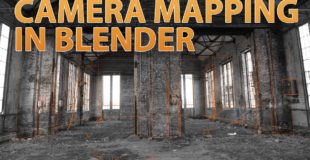https://i.ytimg.com/vi/B9r9tKX5olY/hqdefault.jpg
Finally remade to work with Blender 2.66 🙂 Get the source files and read the text summary: http://www.blenderguru.com/videos/camera-mapping-tutorial-v2/
After countless emails and requests from the blender community, I decided to remake my old camera mapping tutorial, with a fresh scene, so that it works with the latest version of blender.
In this tutorial you will discover:
-What camera mapping is
-How camera mapping can be used with stunning results
-How to camera map any still photograph
source

20 responses to “How to do Camera Mapping in Blender”
Hi Andrew and thank you very much for this really helpful tutorial. Could you please explain in a short tutorial how to get rid of the distortion of the mapped textures? I would like to create a camera mapping scene in Blender based on a realistic photograph from a house but I would like to move the camera on top of the house (as a bird view). But the original mapped textures dont work. How can I fix that. Thank you very very much, Andrew.
I laugh when you agonize over trying to align your camera and background image to the geometry. Before there was such a thing as auto-tracking matchmove programs, this is how matchmoving was done. So imagine having to perfectly align every frame of a several hundred frame moving camera shot manually. That was my job for several years, and I was happy to have it. CG effects looks glamorous on the surface, but can be a sweatshop underneath.
To avoid the distorted effects of the camera mapping viewed from odd angles, I think you have to use numerous photographs taken from many angles – preferably square on to the surface. Then you can create several projection maps or texture the surfaces directly. But this is good for a quick and dirty one-off effect.
I need a sip of my bread after this.
17:10 "If you go completely hard, […] it's too obvious…" – Andrew, 2013
that isn't a brick is a tape dispenser
31:00 I expected that not to work tbh.. you could define your edges in photoshop and it would be perfect..
Amazing tutorial !
Pls is it possible to export your camera projection datas from blender to after effects?
You could use blam
Motion graphics in Blender is hard but possible. I wanna see one movie created using this.
Great tutorial Andrew. Subscribed ! One trick when editing with Gimp (copy pasting stuff). Duplicate the current layer and chop off the parts that are not needed ! 😉 then we don't get the pasted layer in the middle.
when in photoshop, when taking a part of a layer, intead of copy/pasting it, you should do ctrl+j, with the selection desired to cut, and layer selected, it will NEVER move the result away.
zoom zoom zoom i could not watch because you zoom in and out in reped motion it cept on making me feel dizzy. SORRY
Now that BLAM is out, things are much simpler! 🙂 🙂
I'm not sure if anyone mentioned about using Blam addon for camera calibrate in blender. It's so easy that even I can working with camera mapping:D
this guy looks like he could make some good gaming levels
lol 17:10
Thank you Andrew!
What can we use this tutorial for? Well, I would use it for 2d animation- to take layout backgrounds and fly through them in 3d space. Pretty awesome. Thank you, thank you, thank you!
For anyone having trouble matching the camera with the image. Go find the BLAM plugin for blender 2.6+.
It will help you auto calibrate the camera.
can you camera map a person?
Thanks 🙂